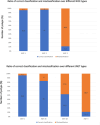Impact of narrow band imaging in prediction of histology of advanced colorectal neoplasia
- PMID: 39789214
- PMCID: PMC11718093
- DOI: 10.1038/s41598-025-85669-w
Impact of narrow band imaging in prediction of histology of advanced colorectal neoplasia
Abstract
We assessed the diagnostic performance of the Narrow-Band Imaging (NBI) International Colorectal Endoscopic Classification (NICE) and the Japan NBI Expert Team classification (JNET) in predicting histological outcomes of advanced colorectal lesions. Additionally, we evaluated the sensitivity and positive predictive value (PPV) of the JNET and NICE classifications individually for high-grade lesions (including HGD adenomas, intramucosal carcinomas, and T1 carcinomas). This was a retrospective analysis of prospectively collected data, involving 211 patients (130 men, mean age 60 years) who underwent colonoscopy with endoscopic resection of advanced colorectal neoplasia (lesions ≥ 10 mm). Lesions were classified using both NICE and JNET criteria, and final histopathological results were used for comparison. Of the 257 lesions analyzed, the NICE classification accurately classifies a large proportion of lesions (93.8%). In JNET classification we observed 77.4% correctly classified lesions. Specifically, the sensitivity and positive predictive value (PPV) of the NICE classification for high-grade lesions were 100% and 24.4%, respectively. For the JNET classification, the sensitivity and PPV for high-grade lesions were 56.6% and 57.7%, respectively. The JNET classification, with a positive predictive value of 57.7% for high-grade colorectal lesions (including HGD adenomas, intramucosal carcinomas, and T1 carcinomas), should be used for decision-making regarding appropriate subsequent endoscopic therapy.
Trial registration: ClinicalTrials.gov NCT03434925 NCT05929365.
Keywords: Colon tumour; Colonoscopy; Diagnostic accuracy; JNET classification; NICE classification; Narrow-band imaging.
© 2025. The Author(s).
Conflict of interest statement
Declarations. Competing interests: The authors declare no competing interests.
Figures



References
-
- Bray, F. et al. Global cancer statistics 2022: GLOBOCAN estimates of incidence and mortality worldwide for 36 cancers in 185 countries. CA Cancer J. Clin.74(3), 229–263 (2024). - PubMed
-
- Kahi, C. J., Imperiale, T. F., Juliar, B. E. & Rex, D. K. Effect of screening colonoscopy on colorectal cancer incidence and mortality. Clin. Gastroenterol. Hepatol.7, 770–775 (2009). - PubMed
-
- Ferlitsch, M. et al. Colorectal polypectomy and endoscopic mucosal resection: European Society of Gastrointestinal Endoscopy (ESGE) Guideline - Update 2024. Endoscopy56, 516–545 (2024). - PubMed
-
- Hosotani, K. et al. Can advanced endoscopic imaging help us avoid surgery for endoscopically resectable colorectal neoplasms? A proof-of-concept study. Dig. Dis. Sci.65, 1829–1837 (2019). - PubMed
Publication types
MeSH terms
Associated data
Grants and funding
LinkOut - more resources
Full Text Sources
Medical

